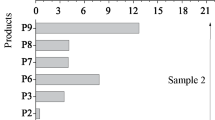Abstract
Deuterium labeled tributyl phosphates were synthesized and their solutions in n-dodecane have been investigated for γ-radiolytic degradation up to an absorbed dose of 2,000 kGy from a 60Co source. The performance was compared with undeuterated TBP. Radiolysis extent and pattern of formation of major degradation products, viz. dibutyl hydrogen phosphate and monobutyl dihydrogen phosphate were found to be very similar from deuterated or undeuterated samples. Extraction behavior for UO2 2+ and Pu(IV) was studied after the radiolysis, and the results showed similarity in extraction/stripping behavior for all labeled or unlabeled TBP samples. The isotope effect (k H/k D) observed is minimal in this γ-radiolytic degradation study.













Similar content being viewed by others
References
Schulz W, Navratil JD, Talbot AE (1984) Science and technology of tributyl phosphate. CRC Press, Florida
Wright A, Paviet-Hartman P (2010) Review of physical and chemical properties of tributyl phosphate/diluent/nitric acid system. Sep Sci Technol 45:1753–1762
Irish ER, Reas WH (1996) The PUREX process-a solvent extraction reprocessing method for irradiated uranium. General Electric, Washington
Mincher BJ, Elias G, Martin LR, Mezyk SP (2009) Radiation chemistry and the nuclear fuel cycle. J Radioanal Nucl Chem 282:645–649
Davis W Jr (1984) In: Schulz W, Navratil JD, Talbot AE (eds) Radiolytic behavior. CRC Press, Florida, p 221
Mincher BJ, Modolo G, Mezyk SP (2009) The effects of radiation chemistry on solvent extraction: 1. Conditions in acidic solution and a review of TBP radiolysis. Solvent Extr Ion Exch 27:1–25
Tripathi SC, Ramanujam A, Gupta KK, Bindu P (2001) Studies on the identification of harmful radiolytic products of 30% TBP-n-dodecane–HNO3 by gas–liquid chromatography. II. Formation and characterization of high molecular weight organophosphates. Sep Sci Technol 36:2863–2883
Sharma JN, Ruhela R, Singh KK, Kumar M, Janardhanan C, Achutan PV, Manohar S, Wattal PK, Suri AK (2010) Studies on hydrolysis and radiolysis of tetra(2-ethylhexyl)diglycolamide (TEHDGA)/isodecyl alcohol/n-dodecane solvent system. Radiochim Acta 98:485–490
Nowak Z (1977) Radiolytic degradation of extractant-diluent systems used in the PUREX process. Nukleonika 22:155–172
Lasage D, Virelizier H, Jankowski CK, Tabet JC (1997) Identification of minor products obtained during radiolysis of tributylphosphate (TBP). Spectroscopy 13:275–290
Lamouroux C, Virelizier H, Moilin C, Jankowski CK (2001) Application of gas chromatography–tandem mass spectrometry to the analysis of inhibition of dimerisation of tributylphosphate under radiolysis. Identification of isomeric tributylphosphate-alkylbenzene inhibitor coupling products. J Chromatogr 917:261–275
Lasage D, Virelizier H, Jankowski CK, Tabet JC (1998) Identification of isomeric tributylphosphate dimers formed by radiolysis using tandem mass spectrometry and stable isotopic labeling. Eur J Mass Spectrom 4:47–54
Ginisty C, Guillame B (1990) Solvent distillation studies for a purex reprocessing plant. Sep Sci Technol 25:1941–1952
He H, Lin M, Muroya Y, Kudo H, Katsumura Y (2004) Laser photolysis study on the reaction of nitrate radical with tributylphosphate and its analogues-comparison with sulfate radical. Phys Chem Chem Phys 6:1264–1268
Mincher BJ, Mezyk SP, Martin LR (2008) A pulse radiolysis investigation of the reactions of tributylphosphate with the radical products of aqueous nitric acid irradiation. J Phys Chem 112:6275–6280
Tahraoui A, Morris JH (1995) Decomposition of solvent extraction media during nuclear reprocessing: literature review. Sep Sci Technol 30:2603–2630
Nowak Z, Nowak M, Seydel A (1979) The radiolysis of TBP–dodecane–HNO3 systems. Radiochem Radioanal Lett 38:343–354
Tsujino T, Ishihara T (1966) Changes to plutonium extraction behavior of TBP and alkylamines through irradiation. J Nucl Sci Technol 3:320–325
Kawaguchim Y, Morimoto K, Kitao T, Ohyama K, Omori E (2009) Study of solvent degradation in reprocessing mox spent fuel; solvent degradation and its effect on Pu purification cycle. Trans Atom Energy Soc Jpn 8:221–229
Tripathi SC, Bindu P, Ramanujam A (2001) Studies on the identification of harmful radiolytic products of 30 % TBP-n-dodecane-HNO3 by gas liquid chromatography. I. Formation of diluent degradation products and their role in Pu retention behaviour. Sep Sci Technol 36:1463–1468
Tripathi SC, Sumathi S, Ramanujam A (1999) Effect on solvent recycling on radiolytic degradation of 30% tributyl phosphate–n-dodecane-HNO3 system. Sep Sci Technol 34:2887–2903
Wilkinson RW, Williams TF (1961) The radiolysis of tri-n-alkyl phosphates. J Chem Soc 4098–4107
Kuruc J, Zubarev VE, Bugaenko LT, Macášek F (1988) ESR spectra of radicals at a low-temperature x-radiolysis of phosphates. J Radioanal Nucl Chem Lett 127:37–49
Gillbro T, Lund (1974) Energy transfer in γ-irradiated C10D22–C10H22 crystals. Isotope effect on radical formation. A Chem Phy Lett 27:300–304
Miwa GT, Walsh JS, Kedderis GL, Hollenberg PF (1983) The use of intramolecular isotope effects to distinguish between deprotonation and hydrogen atom abstraction mechanisms in cytochrome P-450- and peroxidase-catalyzed N-demethylation. J Biol Chem 258:14445–14449
Westheimer FH (1961) The magnitude of the primary kinetic isotope effect for compounds of hydrogen and deuterium. Chem Rev 61:265–273
Melande LCS, Saunders WH Jr (1980) Reaction rates of isotopic molecules. Wiley, New York
Bell RP (1980) The tunnel effect in chemistry. Chapman and Hall, London
Van Hook WA (2011) Isotope effects in chemistry. Nukleonika 56:217–240
Collins CJ, Bowman NS (1970) Isotope effects in chemical reactions. Van Nostrand Rheinhold, New York
Bigeleisen J, Wolfsberg M (1958) Theoretical and experimental aspects of isotope effects in chemical kinetics. Adv Chem Phys 1:15–76
Kohen A, Limbach HH (eds) (2006) Isotope effects in chemistry and biology. Taylor and Francis, Boca Raton
Wolfsberg M, Van Hook WA, Paneth P, Rebelo LPN (2010) Isotope effects in the chemical, geological, and bio sciences. Springer, Dordrecht
Jancso G (2003) Isotope effects. In: Vertes A, Nagy S, Klencsar Z (eds) Handbook of isotope chemistry. Kluwer, Dordrecht 4:85–116
Hennig C, Oswald RB, Schmatz S (2006) Secondary kinetic isotope effect in nucleophilic substitution: a quantum-mechanical approach. J Phys Chem A 110:3071–3079
Tashiro M, Tsuzuki H, Mataka S, Yonemitsu T (1991) Preparation of valeric acids, pentenoic acids, and γ-valerolactones labelled with deuterium. J Labelled Comp Radiopharm 29:691–701
Mincher BJ, Curry RD (2000) Considerations for choice of a kinetic figure of merit in process radiation chemistry for waste treatment. Appl Radiat Isot 52:189–192
Spinks JWT, Woods RJ (1990) An introduction to radiation chemistry, 3rd edn. Wiley, New York
Peterman DR, Mincher BJ, Riddle CL, Tillotson RD (2010) Summary report on gamma radiolysis of TBP/n-dodecane in the presence of nitric acid using the hydrolysis/radiolysis test loop, INL/EXT-10-19866, Aug. 2010
Venkatasan KA, Robertselvan B, Antony MP, Srinivasan TG, Vasudeva Rao PR (2006) Physiochemical and plutonium retention properties of hydrolytic and radiolytically degraded tri-n-amylphosphate. Solvent Extr Ion Exch 24:747–763
Author information
Authors and Affiliations
Corresponding authors
Rights and permissions
About this article
Cite this article
Sharma, S., Ghosh, S.K., Naik, D.B. et al. Comparative studies on radiolytic degradation of deuterium labeled and unlabeled tributyl phosphates. J Radioanal Nucl Chem 302, 583–591 (2014). https://doi.org/10.1007/s10967-014-3261-4
Received:
Published:
Issue Date:
DOI: https://doi.org/10.1007/s10967-014-3261-4




